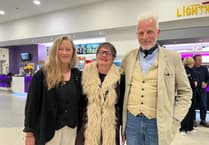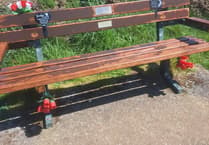A sophisticated aerial survey to map the geology, natural resources and environment of parts of Cornwall is taking to the skies.
A team from the Deep Digital Cornwall Project, led by the University of Exeter’s Camborne School of Mines (CSM) and Institute for Data Science and Artificial Intelligence (IDSAI), is co-ordinating an airborne electromagnetic (AEM) survey over two areas of the county.
The survey is covering around 100 square kilometres at United Downs, near Redruth, and at Redmoor, near Callington.
The survey involves a state-of-the-art sensor being carried beneath a helicopter to measure the natural electrical conductivity of the Earth’s surface and sub-surface, to help reveal the composition of soils and rocks, as well as the location of sub-surface water.
The airborne survey will improve the understanding of Cornwall’s geology including mapping of the granite underground, regional fault systems and location of mineralisation of potential economic interest.
It will help inform, for example:
1) Exploration for minerals that contain the metals required for the transition to net zero, such as lithium, tin, tungsten and copper
2) The potential contribution of geothermal energy to the region’s energy mix
3) Our understanding of hydrogeology and groundwater which is important to mitigate flooding and coastal erosion.
The survey, being operated by New Resolution Geophysics (NRG), is flying at approximately 80 metres over the ground, rising to 240 metres when over more built-up areas, subject to Civil Aviation Authority requirements.
The survey in the two areas is expected to be completed by early March.
Surveying began above United Downs last week.
The new data, which will complement information from previous surveys in the region, including the Tellus South West project, will be made publicly available for further research via the Deep Digital Cornwall Hub and within the Deep Digital Cornwall 4D Visualisation Suite.
The data is being collected in collaboration with project delivery partners Cornish Lithium and Cornwall Resources.
Professor Frances Wall, of Camborne School of Mines, said: “It is really exciting to be flying this state-of-the-art geophysics survey.
“Preparations have been under way for some time to make sure everything is ready, including the official clearances and communication with local residents in the areas where the helicopter will fly.
“We are looking forward to seeing the new data and testing how it helps us understand Cornwall’s important underground geo resources, such as minerals we need for the energy transition and geothermal energy.”
The Deep Digital Cornwall team is posting further information including updates on survey times and locations on the project website, deepdigitalcornwall.org
The aim of Deep Digital Cornwall is to create a world-leading cluster of research-active, highly innovative businesses by researching digital solutions to a wide range of business opportunities connected to the underground including mining, geothermal, civil engineering, environmental, surveying, water resources, planning and permitting, and heritage and tourism.





Comments
This article has no comments yet. Be the first to leave a comment.